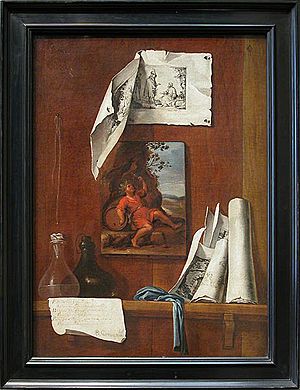Pedro de Campolargo facts for kids
Pedro de Campolargo (born around 1605, died 1687) was a talented artist from Flanders (a region in modern-day Belgium). He was both a painter and an engraver. Engraving is a way of making pictures by carving designs into a surface, usually metal, to print images.
Pedro de Campolargo lived during the Baroque period, a time when art was very dramatic and full of movement. He was part of a large group of Flemish artists who moved to Seville, a big city in Spain, in the second half of the 1600s.
Life Story
We don't know much about Pedro de Campolargo's early life or where he learned his skills. We're not even completely sure of his original Flemish name! Most people believe he was born in Antwerp, a famous art city in Flanders, and learned to paint and engrave there.
The first time we find a record of him in Seville is in 1640. He was there with his wife, Angela Adriaensens, for their son's baptism. Years later, in 1651, he took an important test to become an official "painter of images on plates" (meaning an engraver). In a document, he stated he was "of the Flemish nation" and about 46 years old.
In 1660, Campolargo took on an apprentice, someone who would learn art from him. In Seville, he joined other Flemish artists like Cornelis Schut III and Jan van Mol. Many of these artists, including Campolargo and Schut, helped start and support the Academy of Fine Arts in Seville, which began in 1660. This academy was a school where artists could learn and improve their skills. Until 1663, Campolargo was one of the academy members who promoted the drawing style of the famous Spanish painter Bartolomé Esteban Murillo.
Campolargo is also mentioned in 1671. He was working on a special decoration called a "Triumph elevation" for the Seville Cathedral. This was for the celebrations when San Fernando was made a saint. Campolargo was paid for the prints he made for this event.
He wrote his will in 1675 and passed away in 1687. He had a son, also named Pedro, who also became a painter.
Campolargo was known for working on "minor" art types, which included painting landscapes (pictures of nature) and portraits (pictures of people). He also worked as a stage decorator, creating the scenery for plays or events.
See also
 In Spanish: Pedro de Campolargo para niños
In Spanish: Pedro de Campolargo para niños


